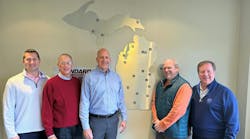The electrical industry has been speculating for years about the strategy and vision of the large distributor consolidators. Where are they taking this industry? What are they thinking? We sat down with some of their top executives and asked. Here's what they said. (First of two parts.)
Far and wide, the question has been asked, is the electrical wholesaling industry consolidating? From inside the electrical community, as one legendary company after another is absorbed into a larger organization, it sometimes looks like cataclysmic change is overtaking the industry. But that perspective may be a bit skewed.
There are certainly many forces encouraging consolidation. A mature industry, over the long run, favors the low-cost provider. Economies of scale allow a company doing the same work to spread fixed costs across a larger revenue base. Over the past few years, thanks to a blossoming economy and a flood of ready capital, waves of consolidation have swept over a number of industries. In banking, automobile manufacturing, telecommunications and many others, giants are merging in a quest for greater economies of scale. It's natural to assume the electrical distribution business will be no different. Yet, despite all the headline-making mergers, this industry has yet to see many really huge deals, such as mergers among top-five firms, that would indicate accelerating consolidation.
This apparent conflict between gut-level impressions and statistics invited further investigation, so last November, Electrical Wholesaling teamed up with a group of merger and acquisition specialists from Brown Brothers Harriman & Co., an investment banking firm on Wall Street in New York, N.Y., to host a roundtable discussion on consolidation in the electrical wholesaling industry.
The object was to bring together executives from some of the most active and most ambitious acquisitors in the industry and pick their brains over lunch. The participants shared their views on a wide range of issues, and the discussion yielded many insights on the course and character of this industry. Here we invite you to sit in on the first part of the conversation, in which we talked about consolidation's impact on the industry as a whole. The second part of the conversation, which you'll be able to read in next month's issue of Electrical Wholesaling, addressed the acquisition strategies of the individual participants and how certain factors affect the value and success of an acquisition.
Electrical Wholesaling moderator: What's driving the increasing level of merger and acquisition activity?
Steve Zepf: Within the electrical industry, it seems there's more of a reluctance to be part of the consolidation game right now. Why that is, I'm not sure. There are more companies for sale in the other industries that we deal in than in the electrical industry. I'm not sure if it's because of the buying groups or the buying power that the smaller and medium players have versus distributors in some of the other industries, but that's part of the game. We do think it will continue to accelerate. It's generational in nature; it's technology driven; it's investment driven. Who has the most purchasing power, and all of those things, will drive it, just like it is in the otherareas of construction materials.
Roy Haley: I agree that the pace is probably s lower (in electrical) than in other industries. I recall a meeting of a group of distributors back in 1995 when NAW's Forces of Change study came out. The subject of consolidation was one of the major conclusions of the NAW research. This was group of significant, influential (electrical) distributors, and their point of view was that it'll happen in other industries but it won't happen in the electrical industry.
I think part of that is driven by intense pride in the development of companies into solid local and regional businesses. And probably some legitimate beliefs that there's a special technical character to the electrical products category that requires a lot of high-touch kind of activity. But I think it's clear when we look at cars or banks or any industry, there is an emphasis on serving customers better through some sort of consolidation and the efficiency that comes from that. Our view is that consolidation will come slowly, but it will come to the electrical industry.
What's really driving us and, we think, some of the companies that we've been affiliated with, is the customer's requirements, more than the historical, generational consolidation-type topics. Customers are looking for uniformity of service, a single point of contact, coordinated contracting and pricing. Across-the-board efficiencies, internal reporting, quality standards and the like. That's what has really driven our whole program-the needs of particular customers and/or industries that we have a strong interest in.
Norm Brown: I agree with both Roy and Steve that it has slowed down somewhat, but I think it's going to continue. Our industry is so fragmented, and therein lies opportunity. But we're going to be driven by the customer, and we're going to be driven by the manufacturer. They've got to find an efficient channel to move their products to the end user, and we've got to step up to the plate and be that efficient channel. Really, the other driving force will be our people. As we move forward, it's harder to hold people in our industry. I think people are looking for professional careers, and I think consolidation's going to offer that.
Tom Formolo: On the utilities side, what we've seen is a movement of customers toward consolidation in anticipation of deregulation. They've focused-in on the things that they're good at, and one of the things that they aren't very good at is managing inventory. They've focused on their core competencies and, in our experience, have looked to farm out all of their inventory procurement and management activities. That has resulted in a trend toward distribution, at least on the utility end, and has raised the bar pretty substantially for utility distributors. That raising of the bar has caused a lot of the smaller players in the industry to fall by the wayside.
I think in part out of fear, maybe, and in part out of not having the right resources, these folks have tried to join up with the larger growing companies in the industry and that's really resulted in quite a lot of consolidation. The people that have sophisticated systems, sophisticated inventory management techniques, well-located distribution locations and capital have been the beneficiaries of that consolidation effort.
Rick McClure: I think there's a lot of fear being created in the very small distributor in the utility industry by the consolidation. Most of them thought they could be successful in some part of the market as long as they had something to sell, but they're not sure if they have anything to sell.
Richard Worthy: If you look behind the issues, there are three factors that will impact consolidation-the end customer, the manufacturers and the distribution-industry-specific factors. To this point, in the electrical industry, there's been limited customer consolidation, particularly on the contractor-flow side of the business.
Manufacturers have been consolidating, but there are four major switchgear manufacturers, and a fifth major line, Allen-Bradley. Each needs a channel to market, they're selling products that are primarily in the mature phase of the product life cycle, and they would like to have as few, and as dedicated, distributors as possible. So consolidation among manufacturers is likely to continue, driving further consolidation in the channel.
With regard to industry-specific factors, those fall into generational and economic-cycle factors. Then there are the capital requirements due to information technology (IT) and the scale of larger distributors, with the people needed to run that scale of businesses. If you look at those capital requirements, and the issues of scale and the IT system, I don't think it's a linear scale. You don't just move along from one point on the cost curve to a higher point on the curve, you go to a second, if not a third or a fourth cost curve. It's an exponential increase. When you go from a $50 million distributor to a $100 million to $150 million, your IT expense as a percentage of revenue can double if not triple or quadruple as a percentage of sales.
Another factor is margin compression. Nontraditional competitors are not just pseudo-threats anymore. They're real; they're significant. Whether it's the big-box home center or integrated supply or the catalog/Web site, they're making the margin compression real, eating into the fringe and part of the core of the electrical distributor's business. It's accelerating, and that in turn drives the need for scale, so you can amortize your fixed cost over a larger revenue base.
Moderator: The government says there are eight- to ten-thousand electrical distributors, altogether maybe 13- to 15-thousand branches out there. At the moment, the four largest distributors have 15% of the market. How consolidated can this industry get, and how fast? We are so far from it.
Haley: Your point's a good one. And in contrast to the point of view that the manufacturers have been leading this and pushing and facilitating the consolidation, you have to look back at the history of the industry. The history of the industry was a small, territorial, local-market focus. That is why you have the number of distributors and the fragmentation that exists in many markets.
I'm reminded occasionally, when I'm asked to look at a situation that maybe is not very healthy, that it takes a long time for a weak competitor to exit the market--a very long time. I see that in many different industries. A couple of airlines, like TWA, have been bankrupt more than once without ever dying off, and I think electrical distributors have a tendency to hang on for a long, long time. Some of that is perhaps supported by financing that is made available by manufacturers.
Zepf: I think the manufacturers have a vested interest in keeping a lot of them out there so it tends to go that way. Also, in the past there weren't as many barriers to entry in the electrical distribution business as there are today, in terms of technology and the amount of investment that's required. So it's not as easy as somebody who used to be a branch manager going down the street and opening up. First of all, you have a much harder time getting lines and everything else that goes along with it to properly serve the customers. So I think that's going to help limit the number of new distributors that are opening up.
The thing that makes it very difficult is, you get down below maybe the top ten electrical distributors in the United States and the sales drop off real quick. So (to build size) you've got to do it step at a time, step at a time. You've got to do every deal independently. Every deal's special--you've got to take into consideration the differing personalities. It can take a long time to work through.
We find that the smaller- to medium-sized deals are more time-consuming because the owners are closer to the business, to the people and everything else. So it takes a longer time to get them done than a big one does.
Worthy: I'd have to guess, and it's just a guess, that in some cases the diversity of customers will constrain consolidation. For example, in the contractor business, you could state a wonderful theory that says there might be three players left in that business coast-to-coast. One would specialize in residential, the other two in large- to medium-size project-related business. Unfortunately that doesn't serve the customer that well because in many cases the customers need four or five lines of credit to be able to operate. That dynamic on the construction side of the business could be a tremendously limiting factor.
Moderator: Are there categories of firms within the industry that are more vulnerable than others to those forces pushing consolidation?
Haley: Our point of view is that the small distributor can and will survive. It's just a question of how they choose to compete and on what dimension or scope they choose to compete. Some of them see they can compete in specific regional geographies or in niches where they have specialization. But again, some that choose to affiliate with another organization look at that (affiliation) as an opportunity to compete on a larger scale-instead of a shrinking perimeter, an expanding perimeter. Our focus is really not vulnerability.
Moderator: Are there categories of distributors that have more to gain from linking up with larger players?
Formolo: I think the ones that are apt to gain the most are the ones that are falling further behind--where you start to see that separation between the largest players and the smallest players in the industry. I think that the greatest amount of activity is on the smaller end, because those people don't have the capital or the resources typically to be competitive in a local market over the long haul. The smaller players aren't cost-competitive at some point. So they hang on to the relationships that they have. But then ultimately there seems to be an accelerating phenomenon towards consolidation. We have seen this take place in many different industries.
Haley: The contrarian in me says that those who choose to affiliate are really looking at where they think they could go if they had the opportunity. I don't disagree that there are certain cases of noncompetitive or deteriorating points of competition where we could improve our performance. But certainly those organizations that we're interested in are those that have a vision of doing something on a larger scale or pushing their own capabilities more extensively. They're looking for an advantage as opposed to trying to remedy a deficiency. Brown: Most of the opportunities we're looking at are situations where it's a matter of providing additional growth opportunities to the company--someone sitting there with a great growth plan where it's all down to execution, and providing the resources.
Moderator: A lot of the smaller distributors put stock in their ability to out-service their national-chain competitors. When we're out in the field talking to distributors we always ask them who their toughest competitors are in town, and it's kind of interesting that the names of the major national chains rarely come up. Is there any truth to the idea that national chains are diluted, so that if you join the national chain it would hamper your ability to compete on a local basis?
Zepf: I think the strength of our company and probably any distribution company is the strength of the branch manager in that particular branch in that community. What you're talking about is really an amalgamation of however many branches you may own of small individual businesses. But if you've got a great branch manager, he ought to be able to compete very effectively against a small independently owned company-theoretically, anyway.
And maybe the smaller people you're talking to don't participate in the same markets as the larger distributors participate in, in terms of customer base. So they don't mention them as being a major factor.
Formolo: In talking with some of the people that we have approached regarding potential acquisition activity, one of our strengths in those meetings has been the fact that we're a focused, utility-only, non-national-chain type of business. There is a subset, of the utility-distributor market anyway, that is very resistant to becoming affiliated with a large national chain--becoming a brand, effectively. By retaining local identity and by being a pure play ourselves, having been brought up and through the utility side since our inception, that's been attractive to a lot of the people that we've dealt with.
Brown: I think our company's philosophy is--it sounds like we want to have our cake and eat it, too--we want to think big and act small in the markets we serve. What we mean by that is we really want to provide horsepower and leverage the horsepower that's available. But we're still entrepreneurially driven, right down to the branch manager level. We want that branch manager to run his business and be involved. We understand that the independent is the biggest horse, and that's the guy we pick--he's the horse you want to ride, generally. Otherwise, we've got to compete with him, so we think the way to go to market is to pass that authority right back down to our branch-manager level.
Worthy: I would say the greatest factor, having been now on both sides of this table, with a chain and running a business that will not be a chain, although we will be very large in scale and magnitude (Editor's note: In a previous life, Worthy spent four years with GE Supply Co.), is the central decision-making versus the local decision-making process. The commitment that exists with these small independent distributors--to the customer, internally with their own employees and their own organization--is one that tends not to change over the years. Much of that is driven by their focus, it's not a process, it's not an IT offering, it's people. Managing people at the local level would appear to have been more successful, if you define success as consistent market-segment focus with low employee turnover. That's based off independent distributors. The question over time will be, can the independent distributor, without the scale and resources the chains will have, compensate with their local-level commitment and nimbleness in a changing economy, or will the chains be able to do the best of both worlds?
Moderator: Do you feel that the buying groups are prolonging the ability of the independent distributors to stay in business, causing less interest on their part in perhaps being acquired?
Zepf: I do. They're getting into the same programs as larger companies. This is all being part of a group so their profitability is enhanced. Plus, some of this is being driven by the customer base anyway, wanting to deal with companies more on a large regional or national basis. Through A-D (Affiliated Distributors, a distributor marketing group Hughes Supply belongs to), even though we aren't a national electrical distributor, we can participate in some of those national account programs that A-D has been able to develop, as can 'Joe's Electrical Wholesaler' in some small town that happens to have a plant outside of it.
Worthy: In our view, we would love to see A-D keep independents alive. I think it enhances the front-line service levels as opposed to generic, headquarters-to-headquarters agreements. National accounts are easier to set up headquarters to headquarters, but given the A-D infrastructure, a small distributor can be part of a Ford Motor Co. solution but retain independence. It's a cost-effective way for smaller distributors to level the playing field. A-D is the equalizer. (Editors' note: Sonepar also belongs to A-D.)
Moderator: Let's talk about the influence of manufacturers on the consolidation process, both as proponents and encouragers of consolidation and also as people who like to influence the way in which the consolidation may occur in a given region of the country.
Zepf: Well, I think the manufacturers all have a vested interest in keeping as big of a customer base as they possibly can. So to that extent, they're going to help supplement the smaller and medium-size players, to keep them in the marketplace. But on the other hand, I think they also have a strong desire to focus their distribution efforts and become more efficient in a lot of these markets.
So there are probably a lot of cross-currents playing there and I'm not sure which one wins out. I know they have brought some deals to us--certain manufacturers have--and said, 'Why don't you look at these guys because they have an interest in talking to you.' They do get involved from that standpoint.
Not so much in electrical but in some of the other areas that we're involved in, if you can't continue to carry the particular line that's important in that industry-like switchgear in electrical or the fixture line in the plumbing industry--for one reason or another, well, then you're pretty much dead from doing that deal. We've had some of those instances come up in a number of industries, where it was just too big of a deal and for whatever reason they didn't want us to have the line in that particular market.
McClure: On the utility side of the business, most of the manufacturers are trying to limit the number of distributors that they deal with nationally and regionally. As they tend to consolidate that, we have fewer players and that has had a significant impact on distribution.
Haley: Just as we see an industry that is complex and fragmented and multidimensional, manufacturers have that same challenge of how to approach the market. Just as our end-use customers are re-engineering and evaluating total cost, the manufacturers have to be rethinking how they manage the distribution of their products. This is a constant change. You see it in how manufacturers deal with distributors, how they deal with manufacturers' reps, and how they deal with their own product lines. So it's a challenge for them, just as it is for us.
Where is this going? I would have to be betting that over time manufacturers will find that there are strong economics for dealing with larger players. Today, many manufacturers' systems and operations are geared to handling lots of small orders. Over time, the economics of those processes will likely change and there will be additional economic reasons to look at the market on a more consolidated basis.
How far are we along on that curve? I would say that we're at the beginning of it, not near the middle or the end.
Brown: I think by and large over the past five years manufacturers' programs for distributors have focused on less distribution and a bigger commitment by a distributor. As that continues to happen, I think you'll see manufacturers doing more of that--just going to market with fewer people and a larger commitment on the distributor side.
Zepf: We're also seeing them ask us to do more, to provide more services that they used to provide. That's more of a reliance on the wholesaler than in the past.
Haley: I think the end-use customer is driving this to a degree that maybe was not seen in the past. Customers are selecting a distributor before they select a manufacturer's line of products. They're depending on the distributor as a value-added partner, as opposed to trying to sort out how they deal with 50 or a hundred or a thousand different manufacturers. Because of that, I think the distributor's brand, if you will, becomes more important. It describes the characteristics of the service package on a large-scale basis. From the standpoint of distributors, I think a beneficial shift is taking place.
Worthy: I think they (manufacturers) are torn. They know where they would like to get to. But they're at point A today, they'd like to get to point C. It's those points in between that are difficult. There are too many factors that they do not control. For years, if not decades, the focus of industrial/OEM manufacturers was penetration. In flow-goods it has always been coverage. Today some of the people who wanted coverage want less distribution. But under one distributor's roof, one manufacturer might consider it a coverage account, and another manufacturer might consider it a penetration account. So the ability for a distributor who has to carry multiple manufacturers' lines is limited--if you're an Allen-Bradley distributor but you also happen to be in the contractor game, what are you? A-B likes you to have a tightly defined territory, and rightly so for their combined product lines. On the contractor side, particularly with (manufacturers of) some of the flow goods, pipe and wire, a manufacturer would want volume because that's what drives productivity in their factory.
Because there's not much clarity on the role that a distributor plays in a more general sense, it's difficult to align all the stars to where there's one or at most two distributors for each key manufacturing line in a trading area. Distributors wear so many different hats.
To be continued. In Part II of this discussion, which will appear in the February 1999 issue of EW, the participants discuss their companies' strategies and how certain factors affect the value they place on an acquisition prospect.
Beginning with this article and continuing throughout 1999, Electrical Wholesaling's editorial staff will explore the key changes facing electrical distributors as they prepare their businesses for the 21st century, such as consolidation, information technology and related electronic commerce issues, succession planning and new market development. These articles will focus on the strategic investments that most electrical distributors will have to make in these areas to do battle with ever-larger competitors, alternate channels and new forms of competition as yet unseen.--The Editors
Code Hennessy & Simmons, Chicago, Ill. Tom Formolo, partner
Temple Electric, Inc., Dallas, Texas Rick McClure, chief executive officer,
Hughes Supply Co., Orlando, Fla. Steve Zepf, chief financial officer
Rexel, Inc., Coral Gables, Fla. Norm Brown, vice president--corporate development
WESCO Distribution, Inc., Pittsburgh, Pa. Roy Haley, president and chief executive officer
*Sonepar Distribution US, Reading, Pa. Richard Worthy, president and chief executive officer
The Moderators Andrea Herbert, editorial director, Electrical Wholesaling Doug Chandler, managing editor, Electrical Wholesaling Richard Witmer, partner, Brown Brothers Harriman & Co. Peter Nesvold, associate, Brown Brothers Harriman & Co.
*Due to a last-minute complication, Worthy was unable to join us at the table, and is not present in the photographs. He was asked the same questions by telephone following the meeting, and his comments were added to the end of the discussion on each question.
Pittsburgh, Pa. Number of locations: 330
Recent acquisitions of note: Reily Electrical Supply, Metairie, La.; Bruckner Supply Co., Port Washington, N.Y.
Big and bold WESCO Distribution has been making the most consolidation waves in the electrical distribution industry over the past few years. The company began life as Westinghouse Electric Supply Co., the distribution arm of Westinghouse Electric Corp. WESCO's acquisition hunt began in 1995, a year after Westinghouse sold the company to an investment firm, and the national chain has kept a steady pace of announcements since then, building mass in all sectors of the industry.
While acquisitions have made WESCO a highly visible player, Roy Haley, WESCO's president and chief executive, says acquisitions are just a small part of the company's overall growth strategy. To be an effective acquirer, a company has to be fundamentally strong and capable of growing its base business, he says. WESCO's acquisitions, as a rule, amount to 10% or less of the size of the core company in any year.
The company focuses on adding capabilities that customers specifically request, rather than trying to push initiatives from the top down, he says. "Our customers generally direct us in areas that they would like to see us add capabilities--and it grows in effect from the inside out."
While acquisitions are very important, Haley says, "When we start listing our growth strategies, acquisitions come down as sort of the fourth component with our growth strategy. Although it's very important and we put a lot of energy into it, we don't think you can count on or budget acquisition growth. You never know what deals are going to close or what may be available at a point in time, so we have to be organized and to sustain an effort, but also be very reactive when the need or the opportunity presents itself."
Coral Gables, Fla. Number of locations: 194
Recent acquisitions of note: Pacific Electrical Supply, Inc., San Leandro, Calif.; Taylor Electric Supply, Inc., Portland, Ore.
Rexel, the North American subsidiary of the largest electrical distributor in the world, Paris, France-based Rexel SA, has been a growing force in the U.S. electrical distribution market since 1987. The company's U.S. operations have grown rapidly through acquisitions of some large regional players over the years, such as Southern Electric Supply, Meridian, Miss.; Consolidated Electric Supply (CES), Orlando, Fla.; the Sacks Group, Akron, Ohio; and Summers Group, Dallas, Texas.
Rexel hasn't made any acquisitions since its parent company, Rexel SA, bought up all the company's outstanding stock and took it private. The company is still in the hunt, though, and as its acquisition program proceeds, Rexel is hoping to help independent distributor owners face the future, says Norm Brown, vice president of the company's Southland division.
"There are a lot of challenges to a business owner. I used to call it the 'wide-awakes.' At three in the morning when you're looking at the ceiling wondering all the things on the horizon that are threats to your future--whether there's liquidity for your estate, diversity for your owners, or strategic planning for your business going forward. There's a lot of people out there in that position. We want to be able to meet those needs of the owners."
Rexel's preference is to keep the name, management and market focus of its acquisitions intact, Brown says. "We don't want to rip apart what made a company successful. We want to just provide the items that we think can help it grow in a particular market."
The company's plans going forward call for a continued focus on electrical distribution, but wants to include all phases of electrical distribution, except the utility market.
Orlando, Fla. Number of locations: 435
Recent acquisitions of note: Winn-Lange Electric, Inc., Houston, Texas; Fife/Florida Electrical Supply, Tampa, Fla.
Hughes Supply began life as an electrical distributor, but is now active in nine different disciplines: electrical; electric utility; building supplies; heating, ventilation and air conditioning; pipe, valves and fittings; plumbing; pool and spa; water and sewer; and water systems. The company's geographic strength is in the Southeast, but the company is expanding westward with aspirations of being a national distributor in all nine product groups it serves in the next five to ten years, says Steve Zepf, chief financial officer.
Hughes Supply looks for management that can stay with an acquisition. "There has to be ongoing management, either through the ownership, part ownership, or if they aren't going to stay involved, they've got to have management there that is willing to stay on and run the business for us," Zepf says. "That's very important, because we just don't have bench strength to be able to put our own people out there. We don't bottom fish because we aren't smart enough to fix everything. We have enough problems of our own. We don't need anybody else's."
Other criteria the company pays attention to include fit with strategic goals in terms of geographic diversification, higher margin products, diversification of end-users, and "getting less tied to new residential construction, more into the industrial and replacement markets and all that kind of stuff," Zepf says.
"Then if it gets past all that kind of stuff the final test is, can we buy it where it'll stillbe accretive to earnings per share within 12 months? That's a commitment we made to our board and our shareholders and we've stuck to that. We've been very disciplined in that area. It cost us some acquisitions, but in the long run that's what we have to do. And that's what we will do. That's sort of our strategy and philosophy."
Chicago, Ill. Number of acquisitions: 90
Recent acquisitions of note: Temple, Inc., Grand Prairie, Texas; Houston Wire & Cable Co., Houston, Texas.
Code, Hennessy & Simmons is a venture capital firm that invests alongside management in a variety of industries. A recent concentration has been on electric-utility distributors, where the company is working to build through acquisition a "pure-play" electric-utility specialty distributor of sufficient size to possibly take public.
The utility business is consolidating rapidly. Tom Formolo, partner of Code, Hennessy, expects it to continue until three to five companies hold one-third to one-half of the market. "I would imagine that within a five-year span of time, the top three to five players in the industry will control maybe 50% of the distribution revenue on the utility side," he says. "We'd like to be positioned to be one of those players."
Code, Hennessy tries to expand methodically along geographic coverage and manufacturer lines. "Our focus has been to try to affiliate ourselves with like-minded operators in a industry where relationships are very important, where there's some commonality of customer base, and where there's a logical manufacturer representation. By doing so, we feel we'll be in a good position to be one of the survivors in the industry," Formolo says.
The firm stays flexible on whether a selling owner wants to remain with the company or cash out. Where the target is large, Formolo says the company prefers to build using existing management. "One of the things that makes you efficient and successful as a distribution company is you're not long on corporate resources, typically. We don't have a large infrastructure at Temple that enables us to strap acquisitions on. We have to build as we grow, so as we combine with established firms we look for the fit from a managerial point of view as well."
Reading, Pa.; Number of locations (U.S.): 3
Recent acquisition of note: Eagle Electric Supply, Norwood, Mass.
Sonepar SA, the Paris, France-based international distributor, is a relative newcomer to the United States electrical distribution market, having made its first acquisition in the states in 1998 when it bought Eagle Electric Supply Co., Norwood, Mass. The company has been watching the U.S. market for more than a decade, however, with top executives making occasional visits to the U.S. to discuss possible acquisitions, but the distributors Sonepar wanted to buy weren't interested in selling, says Richard Worthy, president and chief executive officer of Sonepar Distribution US, Reading, Pa. "Some of that has changed due to generational, succession issues, some of it's due to these companies' having now approached the threshold where they see that to go to the next level--to fulfill their vision--they need to be part of a larger organization."
While it may be the new kid in the game, Sonepar has no lack of ambition. Sonepar believes it can bring a different approach to electrical distribution on a broad scale with its intensively decentralized methods. Sonepar's parent company controls $6 billion in sales throughout Europe and North America through an office that employs 22 people. Worthy expects to build in the U.S., over the next five years, a nationwide distributor that is in the top five in sales and profitability and he plans to run it from a headquarters with less than 10 people, based on Sonepar's time-tested methods.
"(In Europe), Sonepar has had many opportunities to centralize and consolidate the business, but it understands what has made it successful and that is the trust of the local manager," Worthy says. "They've grown by acquisitions, and they've been very successful at allowing strong, autonomous managers who needed greater access to capital to grow the business for Sonepar and themselves."







